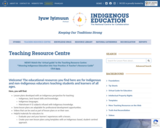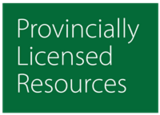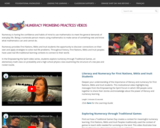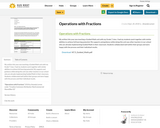
Interactive tasks and games for all grade levels.
- Subject:
- Math
- Material Type:
- Activity/Lab
- Game
- Date Added:
- 06/14/2019

Interactive tasks and games for all grade levels.

The educational resources you find here are for Indigenous and non-Indigenous educators teaching students and learners of all ages.
Here, you will find:
Lesson plans developed with an Indigenous perspective for teaching:
-Indigenous, land-based skills and knowledge;
-Indigenous languages;
-Mainstream K-12 subjects infused with Indigenous knowledge.
Some lesson plans are adaptable for professional development opportunities.
Videos that can be used as part of lesson plans or on their own.
Helpful materials for educators to:
-Evaluate your and your learners’ experiences with a lesson;
-Create your own lesson plans using templates with an Indigenous-based, student-centered approach.
Find lesson plans in: Indigenous Languages, Indigenous Ways of Knowing and Being, On the Land, Art, Music, Commerce or Business, Careers, Science, Biology, Math, Nutrition, Family and Parenting, History, Social Studies.

The National Film Board (NFB) streaming video database includes documentaries, animations, experimental films, fiction and interactive works. The NFB showcases films that take a stand on issues of global importance that matter to Canadians—stories about the environment, human rights, international conflict, the arts and more.Content is available in both French and English.

Today we're going to talk big picture about what Neural Networks are and how they work. Neural Networks, which are computer models that act like neurons in the human brain, are really popular right now - they're being used in everything from self-driving cars and Snapchat filters to even creating original art! As data gets bigger and bigger neural networks will likely play an increasingly important role in helping us make sense of all that data.

A web page and interactive applet illustrating the properties of a nonagon (9 sided polygon). The applet shows a nonagon where the user can drag any vertex to reshape it. User can see that the interior and exterior angles are constant in a regular nonagon, but vary in an irregular version. Controls allow the display or hiding of the diagonals, and triangles within the nonagon. The web page lists the properties of a nonagon including interior angles, exterior angles, sum of exterior angles, area, number of diagonals and number of internal triangles. Links to pages with generalized properties of all polygons. Applet can be enlarged to full screen size for use with a classroom projector. This resource is a component of the Math Open Reference Interactive Geometry textbook project at http://www.mathopenref.com.

Today is the day we finally talk about the normal distribution! The normal distribution is incredibly important in statistics because distributions of means are normally distributed even if populations aren't. We'll get into why this is so - due to the Central Limit Theorem - but it's useful because it allows us to make comparisons between different groups even if we don't know the underlying distribution of the population being studied.

This blog post specifically talks about Number Lines and shows several ways to use them in the classroom that may be new for you!

Students will get a number and record it in the circle. They will then fill in the blank spaces surrounding the number with numbers that come before and after their selected number.
All materials included.

These problems would be great for number talks or higher order thinking.

This site offers short videos about numbers that help kids explore complex math topics and make math more fun.

Numeracy is having the confidence and habits of mind to use mathematics to meet the general demands of everyday life. Being a numerate person means using mathematics to make sense of something new and know what mathematics can and cannot do.
Numeracy provides First Nations, Métis and Inuit students the opportunity to discover connections on their own and apply strategies to solve real life problems. Throughout history, First Nations, Métis and Inuit peoples have used real life traditional learning contexts to connect to their world.
In the Empowering the Spirit video series, students explore numeracy through Traditional Games, an elementary math class on probability and a high school physics class examining the structure of a tee pee and rocket nozzle.

"The learning resources created for the numeracy project include:
*a document that identifies a big idea in a curricular outcome, questions for classroom instruction for student assessment, sample answers shown concretely, pictorially and symbolically and connecting outcomes;
*reference documents that provide further information or resources;
*additional questions across multiple grades for each big idea found in a progression document; and,
short videos.
The numeracy project is a curriculum, instruction and assessment support for mathematics. The learning supports are aligned directly to Saskatchewan curricular outcomes."
Select the grade from the menu on the left to explore available documents. I suggest starting by watching the supporting video provided below the documents. The video provides background and information about the documents.
Select Progressions on the menu on the left to explore by theme. (Coming soon)
PLEASE NOTE THAT NEW RESOURCES WILL BE CONTINUED TO BE ADDED HERE THROUGHOUT THE 2022-23 SCHOOL YEAR. CHECK BACK REGULARLY!

Numeracy Tasks are designed to have students interact with mathematics in a way that is meaningful to them and that strengthens their understanding of mathematics and numbers in the world.
Activities are sorted by the following categories:
Primary (k-3)
Intermediate (4-6)
Junior High School (7-9)
Senior High School (10-12)

An interactive applet and associated web page that demonstrate obtuse angles (those between 90 and 180 deg). The applet presents an angle (initially obtuse) that the user can adjust by dragging the end points of the line segments forming the angle. As it changes it shows the angle measure and a message that indicate which type of angle it is. There a software 'detents' that make it easy capture exact angles such as 90 degrees and 180 degrees The message and angle measures can be turned off to facilitate classroom discussion. The text on the page has links to other pages defining each angle type in depth. Applet can be enlarged to full screen size for use with a classroom projector. This resource is a component of the Math Open Reference Interactive Geometry textbook project at http://www.mathopenref.com.

An interactive applet and associated web page that demonstrate the three types of triangle: acute, obtuse and right. The applet shows a triangle that is initially obtuse (one angle greater than 90 degrees) which the user can reshape by dragging any vertex. There is a message changes in real time while the triangle is being dragged that tells if the triangle is an acute, right or obtuse triangle and gives the reason why. By experimenting with the triangle student can develop an intuitive sense of the difference between these three classes of triangle. Applet can be enlarged to full screen size for use with a classroom projector. This resource is a component of the Math Open Reference Interactive Geometry textbook project at http://www.mathopenref.com.

A web page and interactive applet illustrating the properties of a octagon (8 sided polygon). The applet shows an octagon where the user can drag any vertex to reshape it. User can see that the interior and exterior angles are constant in a regular octagon, but vary in an irregular version. Controls allow the display or hiding of the diagonals, and triangles within the octagon. The web page lists the properties of an octagon including interior angles, exterior angles, sum of exterior angles, area, number of diagonals and number of internal triangles. Links to pages with generalized properties of all polygons. Applet can be enlarged to full screen size for use with a classroom projector. This resource is a component of the Math Open Reference Interactive Geometry textbook project at http://www.mathopenref.com.

Tag Line: Challenging math problems worth solving
A collection of math problems that require some good thinking, and maybe a few attempts. The idea is to move beyond procedural understanding.
The collections are sorted from grades Kinder to High School (for common core standards in the US - but probably transfer well). The problems usually involve some blank spots which must be filled with numbers. In many of the problems you can not use a digit more than once.
Like similar sites that provide these problem style questions, you can submit your own to add to the collection.

My artifact this year was teaching a Guided Math unit with my Grade 7 class. I had my students
work together with similar abilities to achieve full learning potential. My supports and guidance while doing this unit was other teachers in our school who are already implementing Guided Math in their classroom. Students collaborated well within their groups and were happy with the process and their individual results.

An interactive applet and associated web page that demonstrate opposite rays. The applet shows two rays with a common endpoint and can be dragged with the mouse. If the rays are in a line, the message 'Opposite rays' appears. A detent makes it easier to get them perfectly aligned. Applet can be enlarged to full screen size for use with a classroom projector. This resource is a component of the Math Open Reference Interactive Geometry textbook project at http://www.mathopenref.com.

A web page and interactive applet demonstrating the concept of the orthocenter of a triangle. The applet shows a triangle where the user can drag the vertices around. The orthocenter and the altitude lines that generate it are continuously moved as the user drags the vertices. By experimentation the user can observe that the orthocenter can be inside or outside the triangle. The page text explains the definition of the orthocenter and how to find it. Applet can be enlarged to full screen size for use with a classroom projector. This resource is a component of the Math Open Reference Interactive Geometry textbook project at http://www.mathopenref.com.